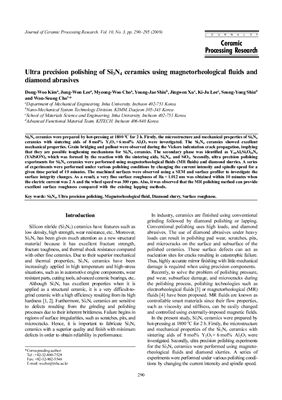Статья. Опубликована в журнале "Joual of Ceramic Processing
Research". – 2009. – Vol. 10, No. 3 – P. 290-295.
Авторы: Dong-Woo Kima, Jung-Won Leea, Myeong-Woo Choa, Young-Jae
Shinb, Jingwen Xuc, Ki-Ju Leec, Seung-Yong Shind, Won-Seung Cho.
Название на русском языке: Ультратонкое полирование керамики Si3N4
с использованием магнитореологической жидкости и алмазных
абразивов.
Аннотация к статье на английском языке:
Si3N4 ceramics were prepared by hot-pressing at 1800 oC for 2 h. Firstly, the microstructure and mechanical properties of Si3N4 ceramics with sintering aids of 8 mol% Y2O3+ 6mol% Al2O3 were investigated. The Si3N4 ceramics showed excellent mechanical properties. Grain bridging and pullout were observed during the Vickers indentation crack propagation, implying that they are possible toughening mechanisms for Si3N4 ceramics. The secondary phase was identified as Y10Al2Si3O18N4 (YAlSiON), which was formed by the reaction with the sintering aids, Si3N4, and SiO Secondly, ultra precision polishing experiments for Si3N4 ceramics were performed using magnetorheological fluids (MR fluids) and diamond slurries. A series of experiments were performed under various polishing conditions by changing the current intensity and spindle speed for a given time period of 10 minutes. The machined surfaces were observed using a SEM and surface profiler to investigate the surface integrity changes. As a result, a very fine surface roughness of Ra = 1.012 nm was obtained within 10 minutes when the electric current was 2 A and the wheel speed was 300 rpm. Also, it was observed that the MR polishing method can provide excellent surface roughness compared with the existing lapping methods.
Si3N4 ceramics were prepared by hot-pressing at 1800 oC for 2 h. Firstly, the microstructure and mechanical properties of Si3N4 ceramics with sintering aids of 8 mol% Y2O3+ 6mol% Al2O3 were investigated. The Si3N4 ceramics showed excellent mechanical properties. Grain bridging and pullout were observed during the Vickers indentation crack propagation, implying that they are possible toughening mechanisms for Si3N4 ceramics. The secondary phase was identified as Y10Al2Si3O18N4 (YAlSiON), which was formed by the reaction with the sintering aids, Si3N4, and SiO Secondly, ultra precision polishing experiments for Si3N4 ceramics were performed using magnetorheological fluids (MR fluids) and diamond slurries. A series of experiments were performed under various polishing conditions by changing the current intensity and spindle speed for a given time period of 10 minutes. The machined surfaces were observed using a SEM and surface profiler to investigate the surface integrity changes. As a result, a very fine surface roughness of Ra = 1.012 nm was obtained within 10 minutes when the electric current was 2 A and the wheel speed was 300 rpm. Also, it was observed that the MR polishing method can provide excellent surface roughness compared with the existing lapping methods.

